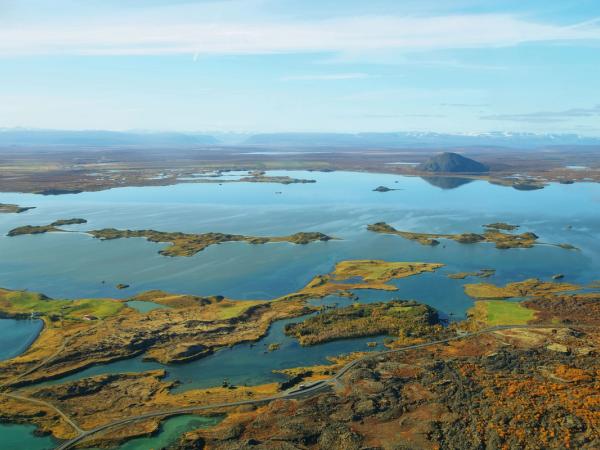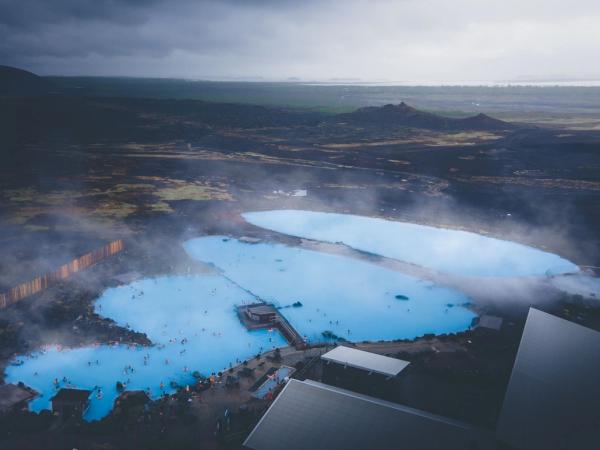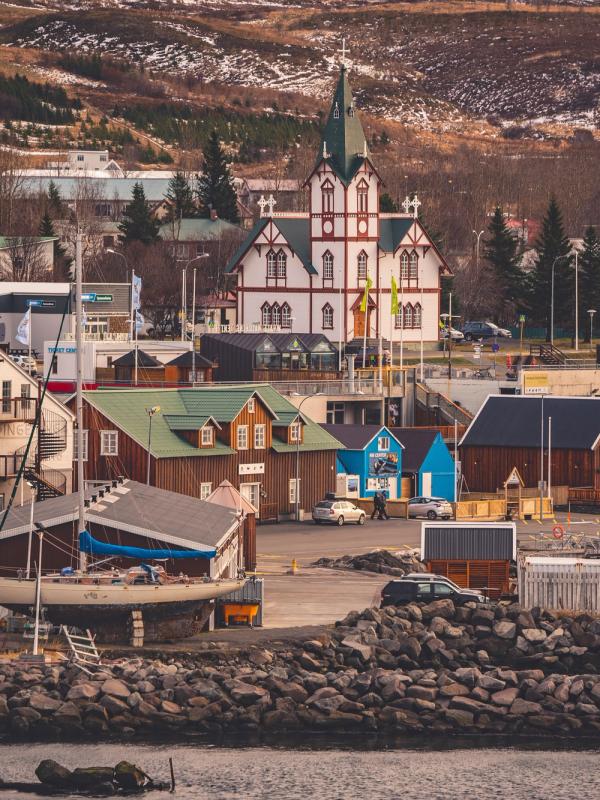
Húsavík, The Whale Watching Capital of Iceland
Most travelers who come to Iceland hope to see amazing natural monuments and get to know Icelandic culture. As part of the experience, many want to discover the wildlife in the country. One of the animals that people seek the most is the whale. The chance of seeing these majestic creatures up close is an added value for many of the people who have chosen Iceland as a destination. And if you’re one of them, you must go to Húsavík.
In this charming town located in North Iceland, there’s much more than just whales. Húsavík is close to many other amazing attractions in the region, where you can find waterfalls, geothermal pools, lava fields, or dramatic landscapes steeped in Norse mythology.
Key Takeaways
- Húsavík is in the region Norðurland Eystra, in North Iceland.
- The town has gained fame as the whale-watching capital of Iceland.
- It’s considered one of the five main stops in the Diamond Circle, a scenic route that connects all these places.
About Húsavík
Húsavík is one of those places that feels like a well-kept secret. With a population of just over 2,500 people, it’s small enough to feel intimate but has enough things to keep you entertained for days. It’s located on the shores of Skjálfandi Bay, a stretch of water full of marine life. Here, you can find whales, dolphins, and puffins.
Walking through Húsavík feels a bit like stepping back in time. The brightly colored houses make the town glow, the picturesque harbor provides a great setting, and the snow-covered mountains in the background make it look like a postcard. But what really sets Húsavík apart is its authenticity—this isn’t a tourist trap but a working town where locals are welcoming and willing to share their slice of Icelandic paradise.
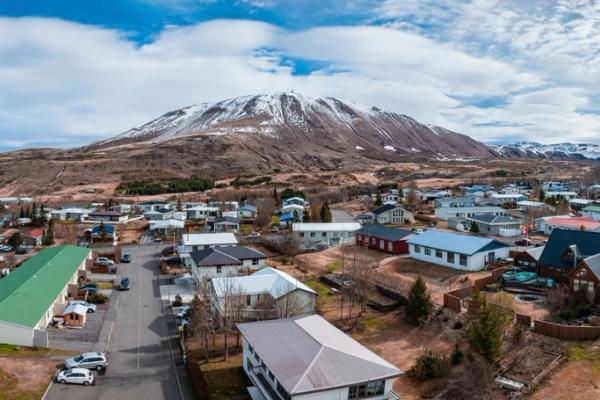
A Brief History of Húsavík
Húsavík’s history began in the 9th century when Swedish Viking explorer Garðar Svavarsson became one of the first Norsemen to spend time in Iceland. Some researchers say he was the first one, but others claim he was second to another explorer called Naddod. Svavarsson built a house on the shores of Skjálfandi Bay, giving the town its name. Húsavík translates to “bay of houses.” While Garðar didn’t stick around, others soon arrived, and the area grew into a prosperous fishing village.
Over the centuries, Húsavík has become an important fishing port with a strong connection with the sea. Today, the town balances its fishing heritage with a booming tourism industry. The town receives visitors from all over the world who want to go whale-watching and discover the natural wonders nearby.

Where is Húsavík and How to Get There
Getting to Húsavík is part of the adventure. It’s located in Iceland’s northeast, about 480 kilometers (298 miles) from Reykjavík. This might seem a lot, but the journey offers some of the most breathtaking landscapes Iceland has.
The best way to get there is by car. If you’re driving from Reykjavík, which is a common starting point for many travelers, start by taking the Ring Road (Route 1) heading north. This route will lead you through several different landscapes, from lava fields to green valleys. After you’ve passed Akureyri—the largest town in northern Iceland—turn onto Route 85, which takes you the rest of the way to Húsavík. The drive takes about six hours, but it can get longer if you make stops.
A good idea could be to get there in a couple of days, planning a stop or two to discover other parts of Iceland.
What to See and Do in Húsavík and Nearby
Despite being quite small, Húsavik offers many cool activities. Actually, I'd argue it offers one of the coolest things to do in Iceland altogether. Plus, it's the perfect base to explore the rest of the attractions in Northeast Iceland.
Whale Watching Tours
No trip to Húsavík is complete without going into Skjálfandi Bay for a whale-watching tour. These waters are full of life, with a variety of species that live here. The bay’s unique ecosystem, rich in plankton and fish, makes it a prime feeding spot for various whale species. Here, we can find humpback whales, Minke whales, orcas, and even the elusive blue whale.
Several companies operate tours, such as North Sailing and Gentle Giants. Each trip usually lasts about three hours, and the experience is as educational as it is amazing. They include expert guides who share fascinating details about the whales, as well as ways to preserve their habitat and the local environment. The best time for whale watching is from April to October, but even during the shoulder seasons, the chance of a sighting is high.
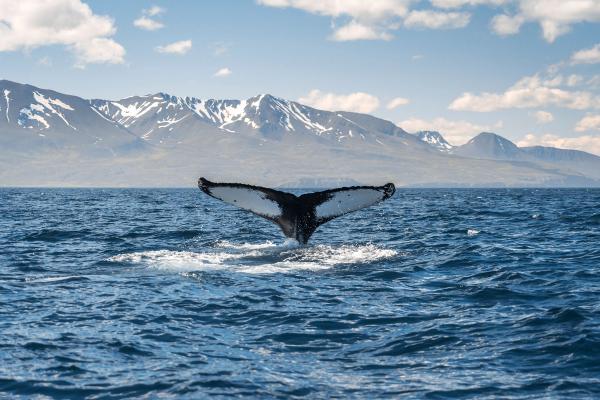
The Whale Museum
If you're a whale enthusiast, you can't miss the Whale Museum in Húsavik. This museum offers fascinating exhibits on the biology, behavior, and conservation of whales, along with 13 real whale skeletons. The museum opens from 9 to 18 during the summer months and from 10 to 16 in winter. Children enter for free, and adults' tickets are 18 USD. There are also guided tours available in English and Icelandic for up to 30 people.

GeoSea Geothermal Baths
One of the top activities in Iceland is taking a bath in one of the many geothermal spots in the country. Now, imagine soaking in warm, mineral-rich seawater while looking at the Arctic Ocean and snowy mountains. That’s exactly what GeoSea Geothermal Baths offers. These baths, located on a cliff above the bay, are a luxurious way to relax after a day of exploring.
What sets GeoSea apart from other geothermal pools in Iceland is its use of seawater, which is naturally heated by geothermal energy. And unlike many hot springs, the pools at GeoSea don’t have the distinct sulfuric smell, making the experience all the more pleasant.
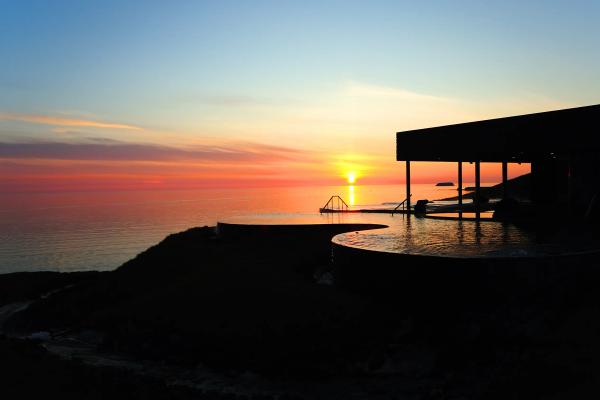
Hike Húsavíkurfjall
This 417-meter mountain sits right behind town and offers amazing views without too much effort. The hike takes about 2-3 hours round trip, covering 4-6 km depending on your route. Most people find it pretty easy - you don't need to be super fit.
The trail gives you great views of Skjálfandi Bay and the Kinnarfjöll Mountains. You'll see wildflowers in summer and might even spot the Arctic Circle on clear days. Regular hiking shoes work fine in dry weather, but bring proper boots if it's been raining - the trail gets slippery.
Pro tip: Pack water and a windproof jacket. Weather changes fast up there. The trailhead has parking, and it's an easy walk from town. Summer offers long daylight hours for evening hikes, while spring and fall mean cooler weather and fewer crowds.
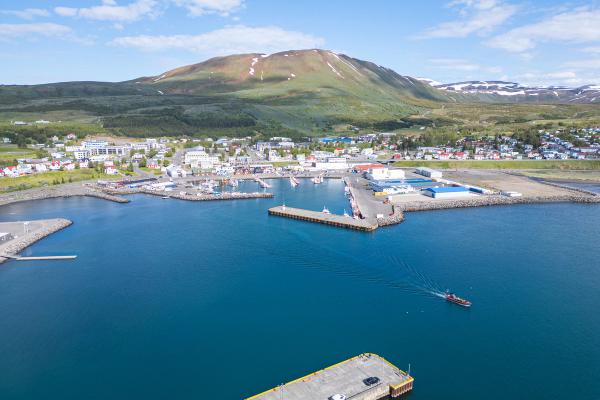
Visit the Eurovision Museum
This museum celebrates Húsavík's moment in the spotlight from the Netflix movie "Eurovision Song Contest: The Story of Fire Saga." It's fun and a bit silly, with movie costumes, props, and chances to sing "Húsavik (My Hometown)."
The museum is in central Húsavík near the harbor. You can take photos with movie backdrops and buy Eurovision merchandise. It's open all year with longer summer hours. Tickets are affordable ($15.50 for adults), with family discounts available.
Smart tip: Visit this and the Whale Museum on the same day since they're close to each other.
Explore Húsavíkurkirkja Church
Built in 1907, this wooden church with its green roof and white walls is hard to miss. It's on Garðarsbraut street in the center of town. The architecture follows traditional Scandinavian design, and inside you'll find pretty stained glass and woodwork.
The church is open during daylight hours, but check first - it sometimes closes for private events. Remember to keep quiet inside since it's still used for worship. The community hosts occasional concerts here, too.

Cross-Country Skiing at Reykjaheiði Ridge
From December to March, Reykjaheiði ridge becomes a cross-country skiing spot right next to town. The gentle slopes work well for beginners and experienced skiers. There are groomed trails from 1-5 km for both classic and skate skiing.
You can rent equipment in Húsavík or nearby Akureyri. Wear layers and bring a headlamp - winter days are short. Beginners can take lessons during peak season. Evening skiing might reward you with Northern Lights views.
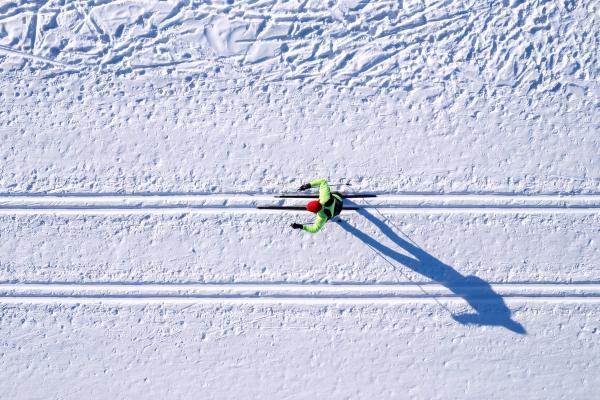
Play Golf at Skeljavíkurvöllur
This 9-hole course sits about 10 minutes from town and offers golf with a view. You can play while looking at Skjálfandi Bay and the surrounding hills. The course is open May through September, weather permitting.
The clubhouse has basic facilities, rental equipment, and a small shop. Natural slopes make the course challenging, and in summer, you can play under the Midnight Sun. Book your tee time early, especially June through August. Visitors are welcome, and green fees are reasonable.
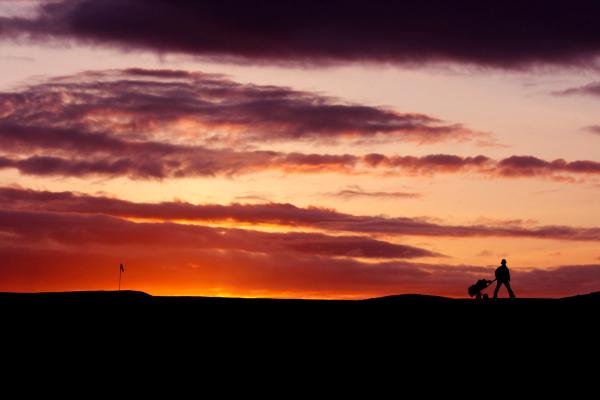
Visit the Húsavík Museum
Located near the harbor, this museum covers local maritime history, crafts, and folk traditions. It's a good complement to the Whale Museum, showing Húsavík's fishing heritage through old equipment, traditional clothing, and household items.
The museum is small enough for a quick visit - perfect for a rainy day or when you need a break between outdoor activities. It helps you understand how this town developed around the fishing industry.
Go Birdwatching in Skjálfandi Bay
Summer brings puffins, Arctic terns, and many other seabirds to the bay and nearby wetlands. Local guides offer birdwatching tours if you want expert help spotting different species.
The best time is May through August during the breeding season. Bring binoculars and a camera with a good zoom. Early mornings and evenings are prime viewing times. You might also spot seabirds while hiking or from the harbor.

Things to Do Nearby
Húsavík is super close to some of the best attractions in North Iceland
Ásbyrgi Canyon
Húsavík is one of the five stops of a fantastic scenic route in North Iceland called The Diamond Circle. The others are Ásbyrgi Canyon, Dettifoss, Goðafoss, and Lake Mývatn. The first one, Ásbyrgi, is a place straight out of myth. This massive horseshoe-shaped canyon is said to be the hoofprint of Sleipnir, the eight-legged horse of the Norse god Odin. It’s about 3.5 kilometers (2.15 miles) long and 1 kilometer (0.6 miles) wide. Ásbyrgi is a stunning spot for hiking and picnicking.
The canyon’s lush vegetation, with birch and willow trees at the bottom, creates a beautiful contrast with the stone walls. There are several trails in the area, ranging from short, family-friendly walks to more challenging hikes.
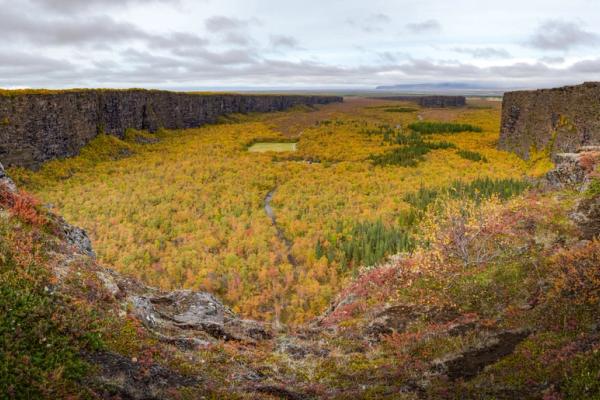
Dettifoss
Dettifoss isn’t just a waterfall—it’s a force of nature. It’s the second most powerful waterfall in Europe, and plunges 44 meters (144 feet) with a thunderous roar that can be heard from a good distance. It’s located about 70 kilometers (43 miles) from Húsavík. One of the best things about Dettifoss is that it’s accessible from both the east and west sides, each one offering different views.
Dettifoss is a humbling reminder of nature’s raw power, and standing beside it is an experience you won’t forget.
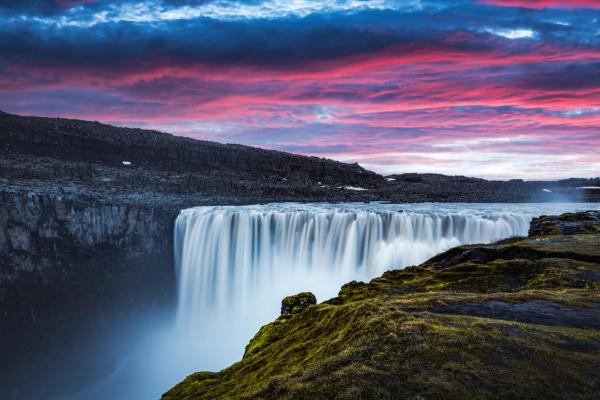
Goðafoss
The next stop in the Diamond Circle is another waterfall. Known as the “Waterfall of the Gods,” Goðafoss is as beautiful as its name suggests. It’s not as big and powerful as Dettifoss, but what sets this place apart is the intense turquoise color of the water.
The name of the falls comes from an Icelandic legend that says that chieftain Þorgeir Ljósvetningagoði threw his pagan idols into the falls when Iceland converted to Christianity around the year 1000. The waterfall is 12 meters high (39 feet) and 30 meters wide (98 feet), with a symmetrical horseshoe shape.
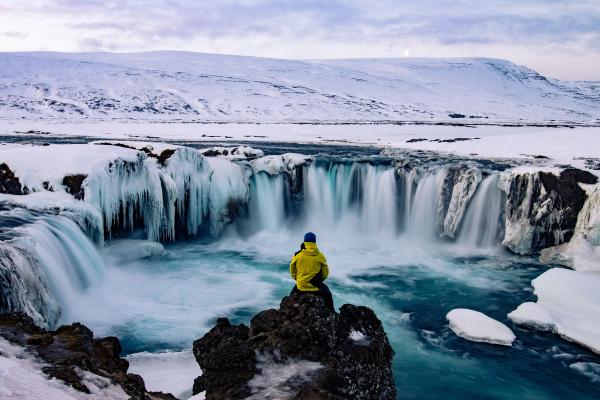
Lake Mývatn and Mývatn Nature Baths
Lake Mývatn is a stunning volcanic landscape just an hour’s drive from Húsavík. The area is known for its strange lava formations, bubbling mud pots, and steam fumaroles. If you like birds, you will be thrilled to know that the lake is home to a diverse number of species, including rare ducks.
Nearby, the Mývatn Nature Baths are another fantastic option to enjoy a warm natural bath in the region. The geothermal waters here are rich in minerals, and the views of the surrounding volcanic landscape are nothing short of spectacular.
Dimmuborgir
Not far from Lake Mývatn, Dimmuborgir, or “The Dark Castles,” is a field of surreal lava formations that looks like it was pulled straight from a fantasy novel. Legends say trolls inhabit the area, and it’s easy to see why. This place is so unique that it’s impossible to stop the imagination from creating stories.
Walking through Dimmuborgir feels like stepping into another world. There are trails of different lengths for you to explore the formations, with some leading to a small cave known as Kirkjan, or “The Church,” due to its cathedral-like shape.

Forest Lagoon
We get now to another location for a geothermal bath. The Forest Lagoon -Skógarböðin in Icelandic- is a private and man-made spa located in the Vaðlaskógur forest near Akureyri. It opened in 2022, and features two infinity pools filled with warm, natural waters sourced from the mountains. The pools are kept at 38°C to 40°C (100°F to 104°F). With stunning views of Eyjafjörður fjord, it’s the perfect place to relax in harmony with nature.
The spa also includes a Finnish sauna, a cold plunge pool, and the Forest Bistro, serving Icelandic cuisine in a beautiful setting. Open daily from 10 a.m. to midnight, it’s a perfect plan all year round. If you come in summer, you can bathe with natural light until late in the evening. In winter, you have the chance to soak underneath the Northern Lights.
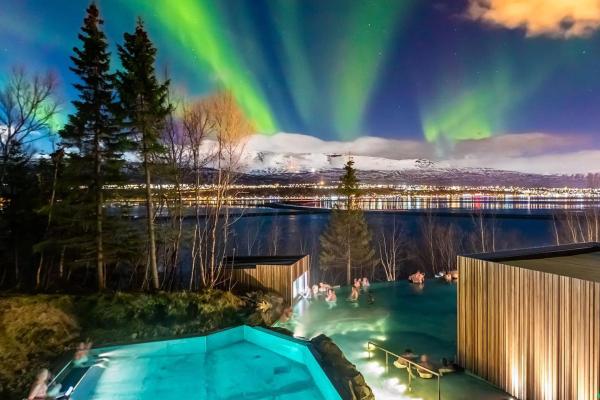
Grjótagjá Cave
Grjótagjá Cave is a hidden gem also near Lake Mývatn. Inside this lava cave, you’ll find a geothermal hot spring with crystal-clear water. Taking a bath here is not allowed due to fluctuating temperatures, but the cave is still worth a visit.
Game of Thrones fans might recognize Grjótagjá as the filming location for a memorable scene with Ygritte and Jon Snow (yes, that one).
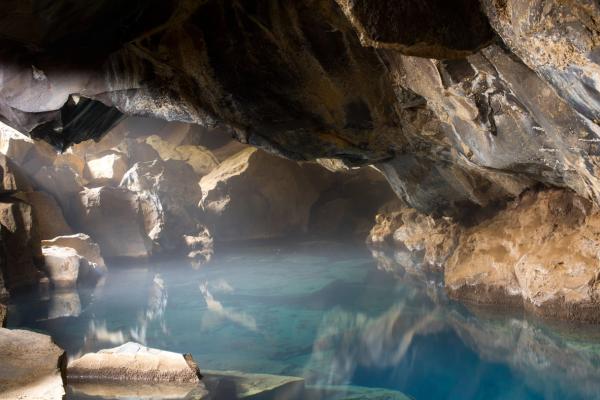
Krafla
Volcanoes are one of the forces that have shaped Iceland through the centuries. Krafla is one of Iceland’s most active volcanic regions, with eruptions as recent as the 1980s. The area is great for geology enthusiasts, with bubbling mud pots, steaming vents, and colorful mineral deposits.
One of the highlights is the Viti Crater, a turquoise geothermal lake surrounded by a surreal landscape. The crater is accessible after a short hike, and the views are well worth the trek.

Tour Grenjaðarstaður Turf Farm
This preserved turf farm 30 minutes south of Húsavík shows what rural life was like in the 1800s. It was a working farm from 1865 to 1948 and now serves as a museum. The turf houses are among Iceland's largest and best-preserved.
Inside, you'll see original furniture, tools, and textiles. Guided tours explain how families survived Iceland's tough climate. There's a small café serving traditional snacks like kleinur (Icelandic doughnuts).
Note: You'll need a car since buses don't go here. It's mainly open June through August, so check the hours first.

Food in Húsavík
Eating out in Húsavík is something that should definitely be on your list. The town’s food scene is a fantastic mix of tradition and innovation. Fresh seafood takes center stage, with many local restaurants serving fish caught straight from Skjálfandi Bay. Arctic char, cod, and langoustine are probably the best options, often served with simple but flavorful side dishes.
For those looking to taste traditional Icelandic recipes, lamb dishes and skyr—the Icelandic version of yogurt—are popular choices. Gamli Baukur is a charming waterfront restaurant that offers Icelandic meals in a cozy setting. Another gem is Naustið, known for its fish soup, which is a local favorite.
Don’t miss the town’s cafés and bakeries, where you can enjoy fresh pastries and coffee. The local bakeries often serve kleinur, a type of Icelandic doughnut.
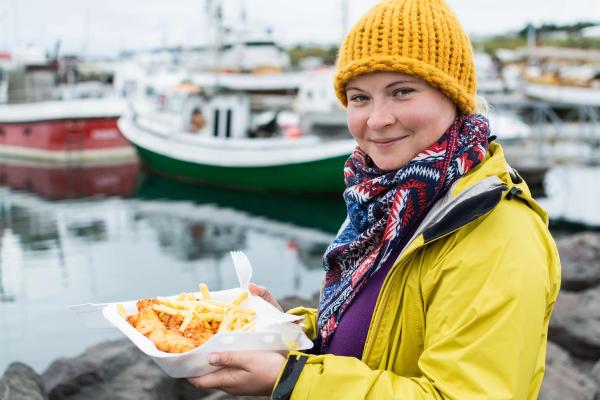
Best Restaurants in Húsavik
Here are some of the best restaurants in town
Gamli Baukur
This restaurant in a historic wooden building on the harbor offers the best views in town. The fish soup is a local favorite, and the grilled cod and lamb shank are excellent too. The interior has wooden beams and nautical touches that feel authentic, not touristy.
They serve good Icelandic beers and sometimes have live music. Outdoor seating in summer is perfect for watching the harbor. It's not cheap, but you're paying for quality food and those views.
Location: Hafnarstétt 9, on the harbor. Book ahead for summer dinners (June-August).
Naustið
This family-run place near the harbor specializes in fresh seafood. The pan-fried cod and lobster tails are standouts, and the seafood platter is great for sharing. They also have vegetarian options and gluten-free dishes.
The nautical-themed interior is cozy, with big windows facing the water. Service feels personal since it's family-run. Don't skip the Skyr cheesecake for dessert.
Location: Naustagarður 2, walking distance from the harbor. Reserve for dinner during busy season.
Restaurant Salka
Housed in one of Húsavik's oldest buildings from the early 1900s, Salka serves traditional Icelandic food. The menu includes Arctic char, lamb stew, and smoked puffin for adventurous eaters. Kids are welcome and have their own menu options.
The interior keeps its historic character with wooden beams and vintage décor. Local craft beers go well with the hearty dishes. It's centrally located and makes a good lunch stop.
Location: Garðarsbraut 6, town center. Open for lunch and dinner.
Hlodufell Restaurant
This place offers something different: Japanese-Polish fusion. They use fresh local fish in both sushi and alongside Polish pierogi. The tempura features Icelandic ingredients, and Polish stews are perfect on cold days.
The modern, simple interior doesn't distract from the food. Staff speak multiple languages, and the menu has good vegetarian and vegan choices. Try the Polish cheesecake or Japanese mochi for dessert.
Location: Central Húsavík. Good for groups with different tastes.
Lókal Bistro
Right on the harbor, Lókal Bistro does casual dining well. Their fish and chips are crispy and fresh, while the gourmet burgers hit the spot after outdoor activities. Harbor views are great, especially from the outdoor seats in summer.
The atmosphere is relaxed with wooden furniture and maritime décor. Service is quick, making it family-friendly. They offer vegetarian and gluten-free options, plus homemade desserts like chocolate lava cake.
Location: Hafnarstétt, directly on the harbor. Usually, no reservation is needed, except for large groups.
Pizzakofinn
When you want a break from Icelandic food, Pizzakofinn makes excellent wood-fired pizzas. They get creative with toppings - try the smoked salmon pizza with Icelandic herbs. The open kitchen lets you watch them make your pizza.
The space is bright and modern and suitable for families. Service is fast if you're between activities. They also do takeaway if you prefer eating by the harbor.
Location: Central Húsavík, near the main street. No reservations needed.
Hérna Húsavík
This café near the Whale Museum serves Italian-inspired food and great coffee. The pasta is solid, paninis are fresh, and the espresso drinks are properly made. It's popular with locals getting their morning coffee and tourists needing caffeine.
The bright interior has an artsy feel with comfortable seating. It's perfect for a quick bite before museums or a longer breakfast. Save room for their gelato or cakes.
Location: Near the Whale Museum. Open daily, morning to evening.
Where to Stay in Húsavík and Nearby
Húsavik has a very decent amount of accommodations for such a small place. Here are some of the best.
- Fosshotel Húsavík: A modern hotel located in the heart of town, Fosshotel offers comfortable rooms and has an excellent restaurant.
- Guesthouse Arbol: This charming guesthouse is set in a historic building surrounded by a beautiful garden. The atmosphere is very welcoming, and the hosts are very friendly.
- Skjálfandi Apartments: Ideal for families or longer stays, these apartments come equipped with kitchens and living spaces. They are located near the harbor.
- Kaldbakur Guesthouse: Situated in the countryside outside Húsavík, this guesthouse offers stunning views of the surrounding mountains.
- Húsavík Cape Hotel: Very close to the whale museum, this boutique hotel combines modern amenities with rustic charm.

The weather in Húsavík
Húsavík’s weather is shaped by its subarctic climate. Each season comes with its own pros and cons. Here’s what you can expect in Húsavík throughout the year.
Summer (June to August)
This is a season of long days and mild weather. Temperatures typically range from 10°C to 15°C (50°F to 59°F), creating a comfortable environment for exploring. The days are really long, with almost 24 hours of natural light per day by the end of June.
The summer months also bring life to Skjálfandi Bay, and it’s the best season for whale-watching. It’s also the perfect time for outdoor activities However, it’s also the busiest time of year, so plan ahead for accommodations and tours.
Autumn (September to November)
Autumn in Húsavík marks a transition from the summer crowds to the quiet calm of winter. Temperatures begin to cool, averaging around 5°C (41°F), and the days get shorter by the week. The landscapes change their colors, with a range of red, orange, and yellow. The first days of snow can happen by mid-October.
This is a quieter time to visit, so it’s great if you prefer fewer crowds. The cooler weather is perfect for exploring local trails or visiting nearby attractions like Ásbyrgi Canyon and Dettifoss. As the days grow shorter, the night skies come alive with stars, and there’s even the chance to see the Northern Lights, which start happening by late Autumn.
Winter (November to March)
In North Iceland, winters are long and cold. Temperatures range between -1°C and -5°C (30°F to 23°F), and snow covers the town and surrounding landscapes.
One of winter’s biggest draws is the chance to witness the Northern Lights. Húsavík is a prime spot for aurora viewing. Guided tours can take you to remote areas for an even better view of this natural show. Although whale-watching tours are less common in winter, some operators still run trips.
Spring (April May)
Spring is a season of renewal in Húsavík. As the snow begins to melt, temperatures rise gradually, ranging from 3°C to 7°C (37°F to 45°F). The ice and snow give way to green fields full of flowers.
Spring is a great time to visit if you want to experience Húsavík before the summer crowds arrive. Early whale-watching tours resume, and the longer days offer plenty of time to explore.
| Seasons | Temperature in ºF | Temperature in ºC |
| Summer (June to August) | 50°F to 59°F | 10°C to 15°C |
| Autumn (September to November) | 41°F | 5ºC |
| Winter (November to March) | 30°F to 23°F | -1°C to -5°C |
| Spring (April May) | 37°F to 45°F | 3°C to 7°C |
Travel Tips
Here are some tips to make the most of your visit to Húsavik and the rest of the Diamond Circle.
- Visit in summer for whale watching: Húsavík is Iceland’s whale-watching capital, and summer (June to August) offers the best conditions to see humpbacks, minkes, and even the blue whale. You never know how these huge mammals will behave, but the sightings in Skjálfandi Bay are almost guaranteed.
- Pack layers: Icelandic weather is famously unpredictable, and Húsavík is no exception. Temperatures can change drastically within a single day, so pack clothes you can layer, including a waterproof jacket and sturdy boots.
- Drive carefully: The rural roads around Húsavík can be challenging, particularly in winter. If you are coming in the colder months or going into gravel roads, it’s highly recommended to rent a 4x4 vehicle.
- Plan for short days in winter: During the winter months, daylight hours in Húsavík are limited to as few as four hours in December. Schedule outdoor activities like sightseeing and whale watching during daylight, and use the long evenings to enjoy indoor attractions or relax in the GeoSea baths or the Forest Lagoon. And, of course, chasing the Northern Lights.
- Book in advance: Húsavík is a popular destination, especially during summer when whale-watching tours are at their best moment of the year. Book your activities and accommodation in advance.
- Respect nature: Icelanders take great pride in their environment, and visitors are encouraged to look after it as well. Stick to marked paths, avoid disturbing wildlife, and leave no trace behind.
- Try the local cuisine: Húsavík’s food scene is delicious, with fresh seafood and fish like Arctic char and cod taking center stage. Lamb meat is very good and tender in Iceland, and take the opportunity to try skyr.
Conclusion
Traveling to Húsavík is a fantastic option to discover some of the best Iceland has to offer. It’s a blend of natural monuments and cultural experiences that you’ll take with you forever. It’s one of the best places in the world for whale watching. It’s also part of the Diamond Circle, one of the best routes to explore in the whole country. Come for the whales, stay for the magic.

